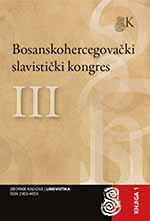Jezična integracija izbjeglica u Hrvatskoj: Dva primjera dobre prakse
Language Integration of Refugees in Croatia: Two Examples of Good Practice
Author(s): Jelena Cvitanušić TvicoSubject(s): Language and Literature Studies, Foreign languages learning, South Slavic Languages, Migration Studies
Published by: Slavistički komitet BiH
Keywords: Croatian for refugees and asylum seekers; service learning; vulnerable group; teachers’ competencies;
Summary/Abstract: Refugees, asylum seekers and asylum holders as foreign language students present a particularly vulnerable group of students and the approach to language teaching should be adapted to their needs and specifics (Đurđević and Podboj 2017). Their language training is the first condition for integration into a new society and inclusion in the labor market, and in this process one of the most important roles is played by state institutions and educational institutions. From the 2017–2018 academic year, Croaticum – Center for Croatian as a second and foreign language at the Faculty of Humanities and Social Sciences in Zagreb has been offering a Croatian language course for asylum seekers and asylum holders. Also, in the 2018–2019 winter semester, a new elective course Croatian as L2 and Service Learning was held at the Department of Croatian Language and Literature. In this article, these two examples of good practice will be described and the role of the (non)institutional organization in language training courses for refugees will be discussed. In the final part, the competencies of the teachers involved in teaching Croatian or refugees will also be addressed.
Journal: Bosanskohercegovački slavistički kongres
- Issue Year: III/2022
- Issue No: 1
- Page Range: 139-152
- Page Count: 14
- Language: Croatian

